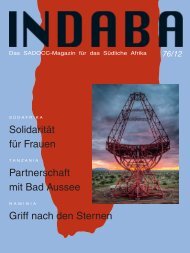Austria and South Africa during apartheid The set-up of ... - SADOCC
Austria and South Africa during apartheid The set-up of ... - SADOCC
Austria and South Africa during apartheid The set-up of ... - SADOCC
Create successful ePaper yourself
Turn your PDF publications into a flip-book with our unique Google optimized e-Paper software.
Anti-<strong>apartheid</strong> activity in the European Community <strong>and</strong> selected West European countries 633<br />
<strong>The</strong> brutal repression <strong>of</strong> the Soweto student revolt from 16 June 1976, reported<br />
by the <strong>Austria</strong>n media, created a rallying point for a wide range <strong>of</strong> people who were<br />
shocked by the attitude <strong>of</strong> the Pretoria government. Only a few had been involved in<br />
solidarity activities with <strong>South</strong> <strong>Africa</strong>, either in the framework <strong>of</strong> the Programme to<br />
Combat Racism <strong>of</strong> the World Council <strong>of</strong> Churches (WCC) or in activities organised<br />
by the <strong>Austria</strong>n Peace Council. 17 Others came from Social Democratic, Catholic <strong>and</strong><br />
Liberal backgrounds. In October 1976, the well-known journalist Adalbert Krims<br />
registered the AAM in <strong>Austria</strong> with the authorities, <strong>and</strong> a few months later, in May<br />
1977, the first annual general meeting took place in Vienna. 18 Furthermore, some<br />
<strong>Africa</strong>n students (whose number in Vienna at that time was rather limited) participated<br />
in AAM’s activities, including Th<strong>and</strong>i Malepe from <strong>South</strong> <strong>Africa</strong>, Peter Julian Jjumba<br />
from Ug<strong>and</strong>a, Sintayehu Tsehay from Ethiopia <strong>and</strong> Joe Kojo Taylor from Ghana.<br />
Contacts with the <strong>Africa</strong>n National Congress (ANC) were immediately established.<br />
Despite good beginnings, it proved difficult for the newly created platform to maintain<br />
the debate on <strong>apartheid</strong> on the <strong>Austria</strong>n political agenda. After the much-reported<br />
meeting between <strong>South</strong> <strong>Africa</strong>’s prime minister John Balthazar Vorster <strong>and</strong> US vicepresident<br />
Walter Mondale in Vienna in May 1977 – marked by the first demonstration<br />
by the young organisation – post-Soweto media interest faded away, <strong>and</strong> even likeminded<br />
political parties did not concentrate much on solidarity activities. <strong>South</strong> <strong>Africa</strong>’s<br />
propag<strong>and</strong>a machinery remained dominant, <strong>and</strong> the first public meeting <strong>of</strong> the AAM –<br />
a lecture by Anthony Mongalo from the ANC at the University <strong>of</strong> Vienna – was almost<br />
disr<strong>up</strong>ted by a gro<strong>up</strong> <strong>of</strong> right-wing, pro-Rhodesian students.<br />
Efforts to make the <strong>Austria</strong>n public aware <strong>of</strong> the situation in <strong>South</strong> <strong>Africa</strong>, <strong>of</strong> the<br />
progress made by the liberation movements, <strong>and</strong> <strong>of</strong> the ongoing collaboration with<br />
<strong>apartheid</strong> <strong>and</strong> colonialism in southern <strong>Africa</strong> were therefore a priority. Apart from a<br />
number <strong>of</strong> information meetings, a symposium on economic collaboration <strong>and</strong> racist<br />
propag<strong>and</strong>a was organised jointly with the <strong>Austria</strong>n UNESCO Commission, <strong>and</strong><br />
addressed by representatives <strong>of</strong> the UN <strong>and</strong> the liberation movements <strong>of</strong> Zimbabwe<br />
<strong>and</strong> <strong>South</strong> <strong>Africa</strong>. Also in 1977, the anti-<strong>apartheid</strong> movement published an information<br />
bulletin, which later developed into a respected magazine on southern <strong>Africa</strong> <strong>and</strong><br />
continues to appear under the new name <strong>of</strong> Indaba. After some lobbying, an <strong>of</strong>ficial<br />
ordinance by the Ministry <strong>of</strong> Education <strong>and</strong> Arts was secured that rejected the regular<br />
sending <strong>of</strong> <strong>South</strong> <strong>Africa</strong>n propag<strong>and</strong>a material to schools <strong>and</strong> its use in educational<br />
activities: a first success against Pretoria’s information dominance.<br />
Obtaining accurate information on developments in <strong>South</strong> <strong>Africa</strong> remained<br />
difficult, given the lack <strong>of</strong> interest by most <strong>of</strong> the media. Furthermore, <strong>South</strong> <strong>Africa</strong>ns<br />
in <strong>Austria</strong> mostly came from the <strong>apartheid</strong> camp. Practically no <strong>Austria</strong>ns in <strong>South</strong><br />
<strong>Africa</strong> were able or willing to provide meaningful information, <strong>and</strong> even academic<br />
research was largely influenced by <strong>of</strong>ficial <strong>South</strong> <strong>Africa</strong>n publications. Personal<br />
17 An affiliate <strong>of</strong> the World Peace Council, which operated independently <strong>of</strong>, but in close co-operation with the<br />
<strong>Austria</strong>n Communist Party.<br />
18 Peter Fleissner was elected first chair. <strong>The</strong> leadership included Ingrid Gaisrucker, Margit Niederhuber, Elfriede Pekny,<br />
Helmuth Rheindorf, Walter Stach, Ulrich Trinks, Klaus Wiesmüller <strong>and</strong> others – all with different political orientations<br />
<strong>and</strong> pr<strong>of</strong>essional experience.<br />
Road to democracy Vol3 P1_5-8.indd 633 31/03/2008 7:36:32





